Traveling to Germany is a wonderful experience. Cities rich in culture and history include Berlin, Cologne, Dresden, and Frankfurt. While Bavaria, Baden-Württemberg, and Saxony’s breathtaking mountains, lakes, valleys, and woods will wow you.
A lot of tiny towns and villages have stunning cathedrals and castles that will entice you in. Even yet, every region’s cuisine and drink will make your taste buds dance.
Deutschland, as the Germans refer to it, offers a plethora of options for tourists. To be honest, you could visit Germany for a whole month and still not be able to do everything there is to do.
Needless to say, your visit will not allow you to see everything. Nonetheless, you ought certainly know more about potential destinations after reading our list of Germany’s best tourist attractions.
30. Schwerin Castle

The medieval palace known as Schwerin Castle is situated in Schwerin. It is among the most significant examples of Romantic architecture from the 19th century that are still standing in Germany.
It is encircled by a lovely park and perched on an island in the city’s lake. Its history extends back to the ninth century. For several centuries, it was the home of various dukes and grand dukes of Mecklenburg-Schwerin.
The current structure was built in the nineteenth century and combines elements of Renaissance and Gothic architecture. The castle’s unique character is derived from the towers, turrets, and ornamental elements incorporated into its design.
One representation of the city’s rich cultural legacy is Schwerin Castle. The castle’s exquisite architecture is on display for visitors to appreciate. Through exhibitions and displays, they may also take in the interior tour and discover more about its fascinating past. Beautiful parks and gardens around the castle offer a peaceful area for guests to unwind.
29. Saxon Switzerland National Park
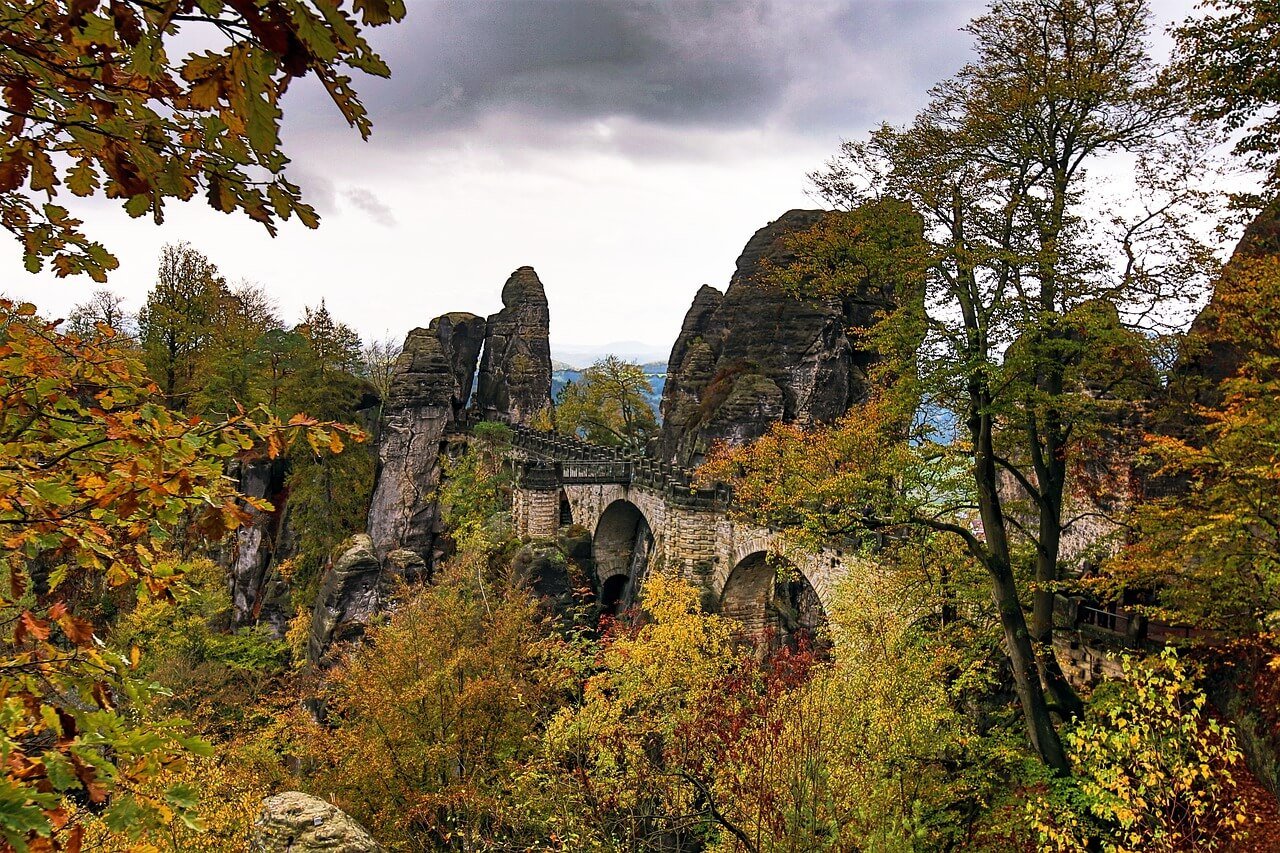
The Saxon Switzerland National Park is a large park next to the picturesque Elbe Sandstone Mountains, and it is not far from Dresden. The park borders the Czech Republic, however it is recognized as the Bohemian Switzerland National Park on the Czech side.
The national park is well-known for its deep valleys, rock towers, and unusual sandstone formations. It is a well-liked location for those who enjoy the great outdoors and the natural world, providing chances for hiking, climbing, and sightseeing.
Due of its resemblance to the Swiss Alps, the park bears the name of the nation. The park’s sandstone formations were formed over millions of years by weathering and erosion. Today, photographers and painters find inspiration in them.
The Bastei Bridge, a sandstone bridge with expansive views of the surroundings, is one of the park’s most well-liked features. The park has several routes for visitors to explore, one of which is the Malerweg. This charming route winds through the park and bears the names of the painters who were moved by the natural beauty of the surrounding region.
28. Sylt

Situated in the North Sea, Sylt is a magnificent island in North Frisian waters. The largest of the North Frisian Islands, it is renowned for the untamed dunes and lovely sandy beaches. Nevertheless, the Wadden Sea National Park remains its primary draw. One of the most well-known islands is Sylt, despite being less accessible to tourists than other German tourist destinations due to its northern location.
In addition to its many beaches, Sylt is home to stunning sand dunes and historic lighthouses. Make a splash at the beach and stay in a modern hotel room within a short stroll from thatched roof cottages and open fields. Another well-liked activity in Syit is to rent bicycles and use them to explore the island.
Sylt is renowned for its historic buildings in addition to its natural charms. This includes the distinctive red-roofed homes there. It also includes elements of the Kampen village’s “Kampen House” style.
27. Aachen Cathedral

The oldest cathedral in northern Europe is the Aachen Cathedral, which is situated close to the borders with Belgium and the Netherlands.
The cathedral’s design combines Gothic and Carolingian architectural elements, and construction on it dates back to the seventh century. King Charlemagne constructed the cathedral, which has hosted numerous coronations over the ages.
When visiting today, the magnificent ninth-century bronze Wolf Doors and the golden mosaics in the Palatine Chapel are two of the most interesting sights to behold.
26. Harz Mountains

The Harz Range, one of Germany’s tallest mountain ranges, is home to serene rivers, snow-capped summits, and charming, traditional residences.
The Harz Mountains served as the inspiration for several of the fairy tales penned by the renowned Grimm Brothers, authors of numerous well-known children’s books.
The Harz slopes are a little off the main path, with few tourists and activities like hiking to the top of the highest peak, Brocken, or taking a real steam train through the valleys and slopes.
25. Old Town Hall in Bamberg
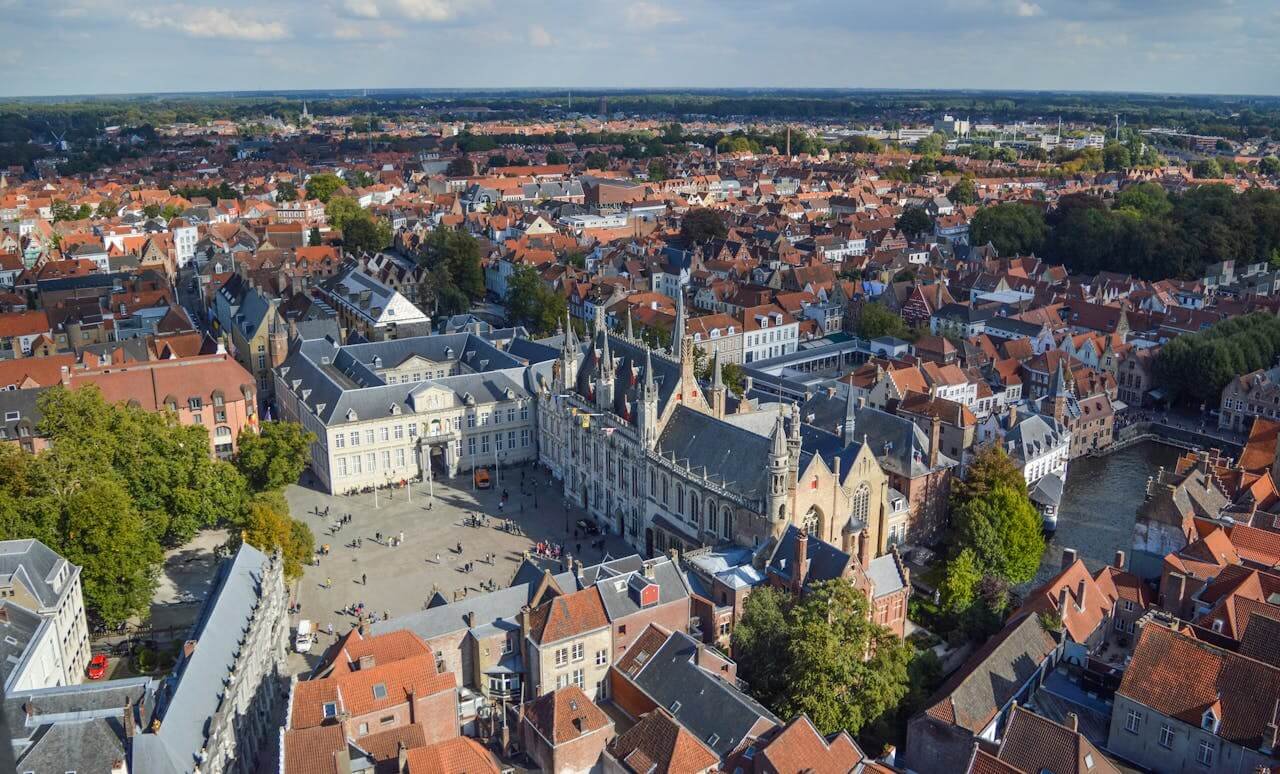
Numerous intriguing architectural landmarks can be found in the medieval city of Bamberg, which is located in Bavaria. Not one is as significant or fascinating as the Altes Rathaus, or Old Town Hall.
According to legend, the town’s bishop forbade the citizens from erecting a town hall on existing property, so they chose to build it in an unusual location. The interior of the Altes Rathaus, which is positioned atop a bridge above the Regnitz River, is exquisitely frescoed.
The building’s Gothic façade dates it to the late 13th and early 14th centuries of construction. It also features a stunning tower and a big hall.
Visitors can have a guided tour of what is regarded as one of Germany’s most exquisite town halls. You will discover more about its architectural and historical significance at this time.
It will also be the subject of several amazing legends, stories, and tales told to you. Among them, the Bamberg Rider is one. This is the supposed haunting of the ghost of a knight who was killed in a duel.
24. Volkerschlachtdenkmal in Leipzig

One of the biggest monuments in all of Europe is located in Leipzig, a significant city in Saxony. To commemorate the Battle of Leipzig during the Napoleonic Wars, the Volkerschlachtdenkmal, also known as the Monument of the Battle of the Nations, was constructed.
More than 100,000 soldiers lost their lives in the fight. The memorial wasn’t unveiled until 1913, despite the fact that the conflict happened in 1813. A museum exhibit that provides additional information about the fight and the Napoleonic conflicts of the 19th century is currently on display alongside the monument.
23. Römer in Frankfurt
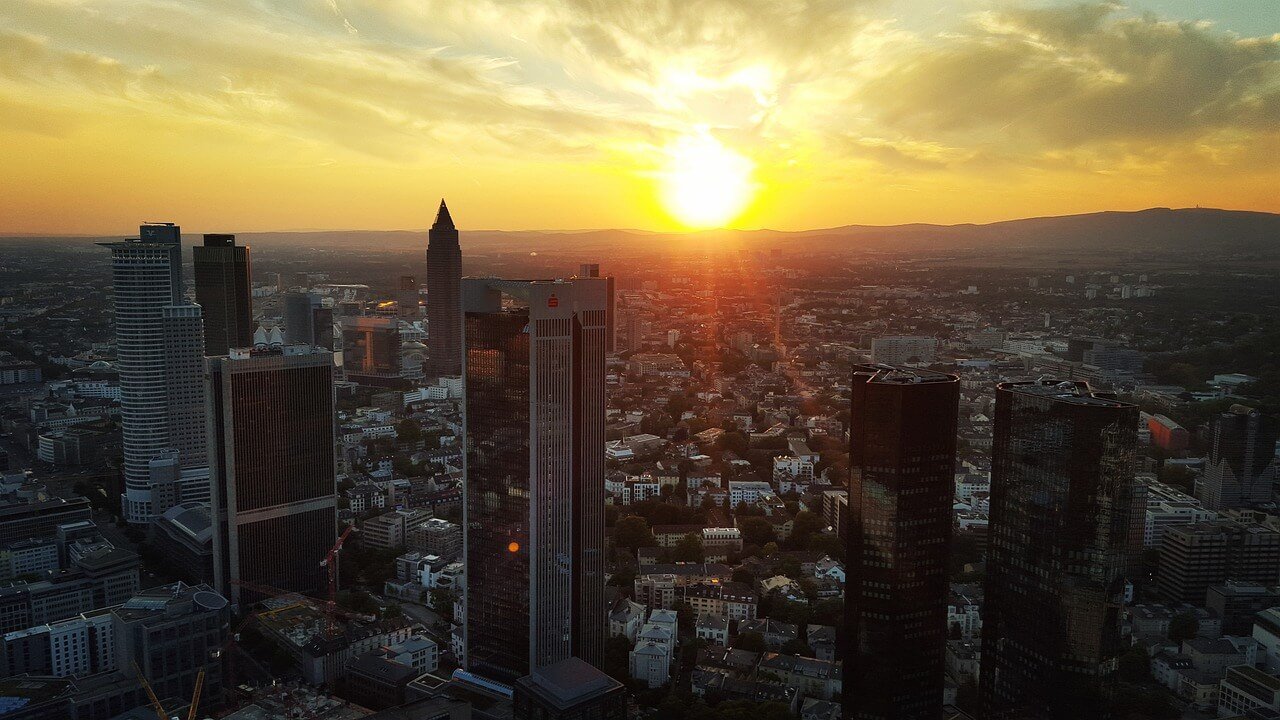
Frankfurt’s historic Römer building complex is located in the city center. It consists of a series of fifteenth- and sixteenth-century half-timbered structures.
Originally constructed as a municipal hall, The Römer is one of the city’s most well-known landmarks. Rich merchants from Frankfurt also called it home. The structures serve a variety of functions now. These consist of a cultural center, city administration offices, and a location for city council sessions.
Admire the exquisite carvings and sculptures on its facades, as well as the lovely half-timbered architecture. The area in front of the Römer, known as the Römerberg, is a well-liked meeting spot. Numerous cultural events, like the yearly Christmas market, are held there as well.
The Römer, a representation of Frankfurt’s lengthy past, provides a distinctive and engrossing window into the past. offering a striking contrast to Frankfurt’s other well-known modern buildings and financial institutions.
22. Speicherstadt in Hamburg

A historic district of Hamburg warehouses is called Speicherstadt. The collection of brick buildings there is among the biggest in the world. Moreover, its characteristic red brick architecture and complex system of canals identify it.
These warehouses, which were constructed in the late 19th and early 20th centuries, held items like textiles, coffee, and spices.
The neighboring Kontorhausviertel and the Speicherstadt were inducted as UNESCO World Heritage Sites in 2015. This was a reward for their outstanding depiction of early modern urban design and architecture. Their historical prominence as a hub of global trade also contributed to it.
Speicherstadt is a bustling neighborhood nowadays with lots of stores, eateries, cafes, and museums. Its distinctive architectural design and interesting past draw travelers. The warehouses’ history and purpose can be learned about by taking a guided tour.
Here are the warehouses as well as the Miniatur Wunderland. It is another well-liked tourist destination and the biggest model railway in the world.
21. Quedlinburg
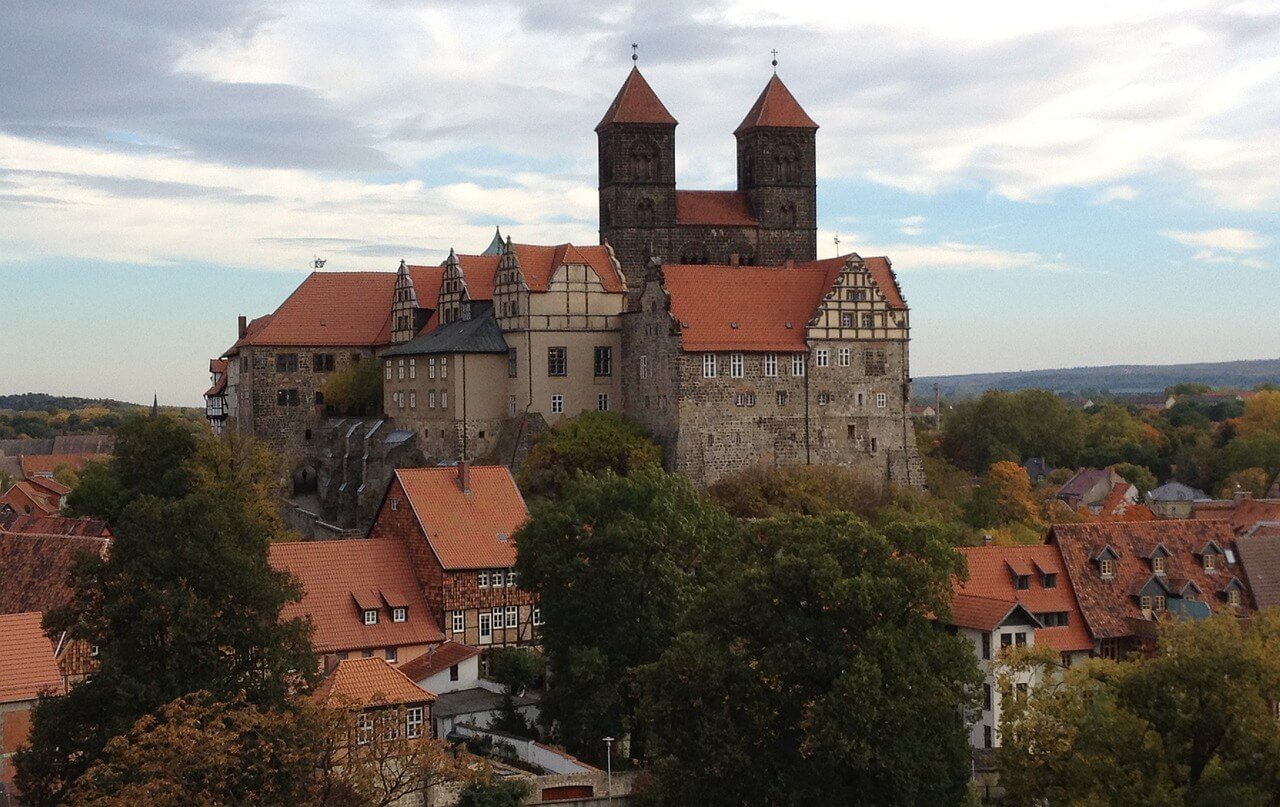
The quaint and scenic village of Quedlinburg is located north of the Harz Mountains National Park. Visitors can see more than a thousand half-timbered homes as they stroll along the cobblestone lanes.
One of the few places in Germany to visit that has maintained its charming, historic architecture is the town, which was spared little damage throughout the World Wars.
While the St. Servatius Church is its primary attraction, the area also boasts an outstanding castle ruin. One of Germany’s oldest churches, it dates to the eleventh century. It is famous for housing the burial of King Henry I, the first German emperor, as well as a number of priceless artworks.
In 1994, Quedlinburg was recognized as a UNESCO World Heritage Site. It also has a rich cultural history that includes a number of customary celebrations and festivals. These consist of the Quedlinburg Christmas Market and the Quedlinburg Festival of Music.
In addition, visitors can taste the regional food and see the Münzenbergmuseum. It’s highly recommended to sample traditional foods like “Harzer Käse” and “Harzer Roller.”
20. Neuschwanstein
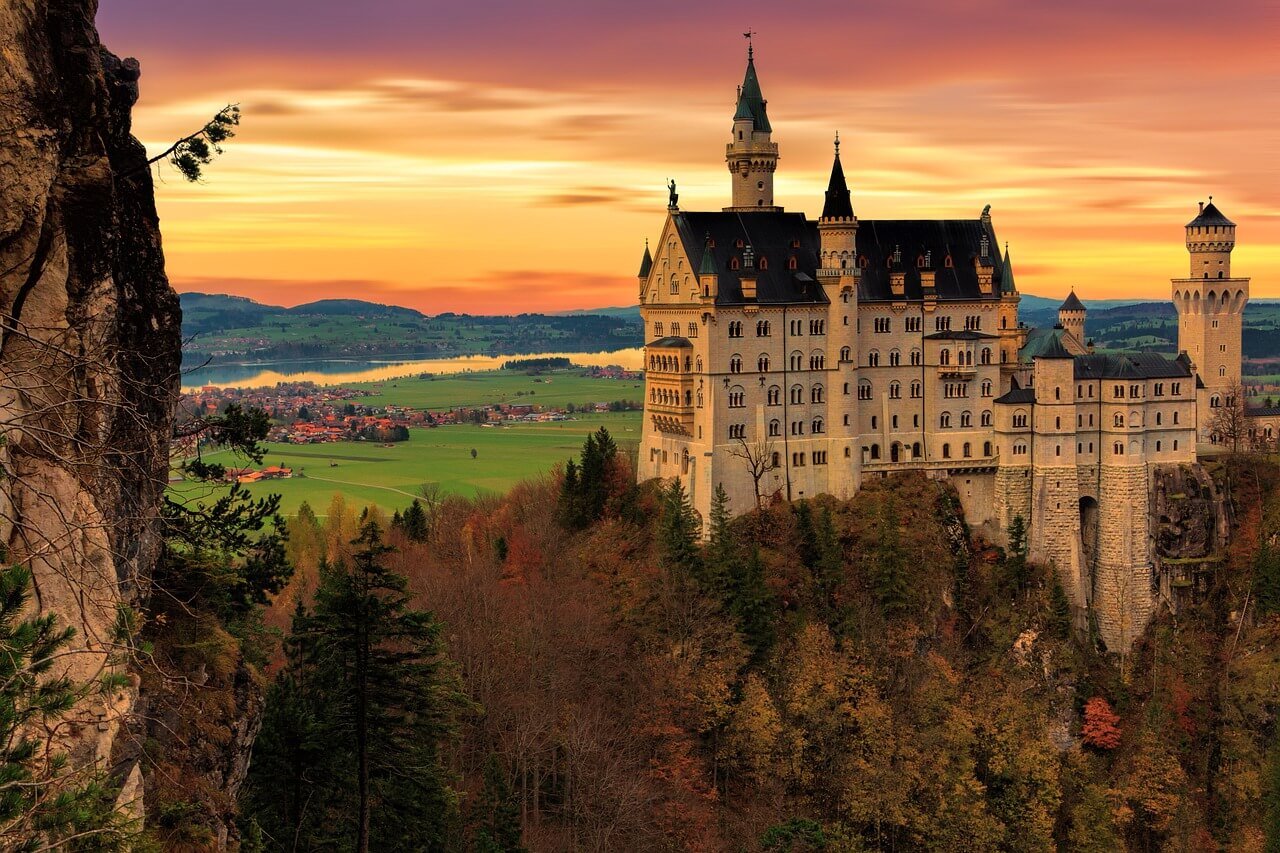
Neuschwanstein Castle, the ultimate castle from a fairy tale, is a 19th-century mansion perched on a precipitous hilltop overlooking the Bavarian settlement of Hohenschwangau.
King Ludwig II ordered it to be built as a retreat with the idea of bringing back the romanticism of the Middle Ages. When the castle was nearly finished in 1886 and the monarch was discovered dead a few days later, it was stated that he was mad.
The castle is currently among the most exquisite specimens of Gothic Revival architecture in all of Europe. Numerous works of literature have been influenced by its breathtaking architecture and picturesque setting in the Bavarian Alps. It is most famous for being the castle in Disney’s Sleeping Beauty.
The only way for visitors to explore Neuschwanstein’s interior is by taking a guided tour. You can examine its elaborate furniture, paintings, and décor if you so desire.
19. Brandenburg Gate in Berlin
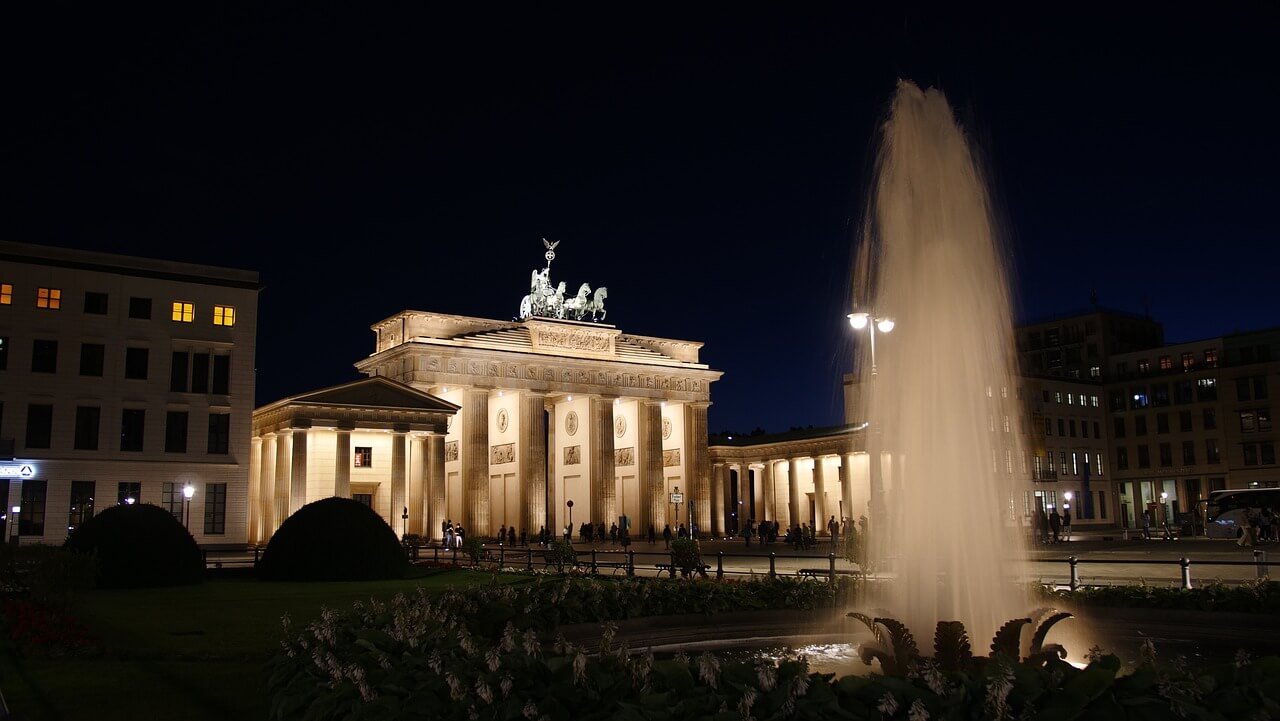
Berlin’s most renowned monument is the Brandenburg Gate.
When it was first constructed in the late 1700s, it was meant to be a representation of peace. One of Germany’s most identifiable sights, the gate symbolizes the reunification of the nation.
It is 26 meters tall and has sculptures in the style of classical Greek art on it. Numerous significant historical events have taken place at the Brandenburg Gate over the years. Among these is the 1989 collapse of the Berlin Wall.
Many people visit it now in order to view it, get their photo taken by it, and remember where they were during that important moment in history.
18. Heidelberg Old City
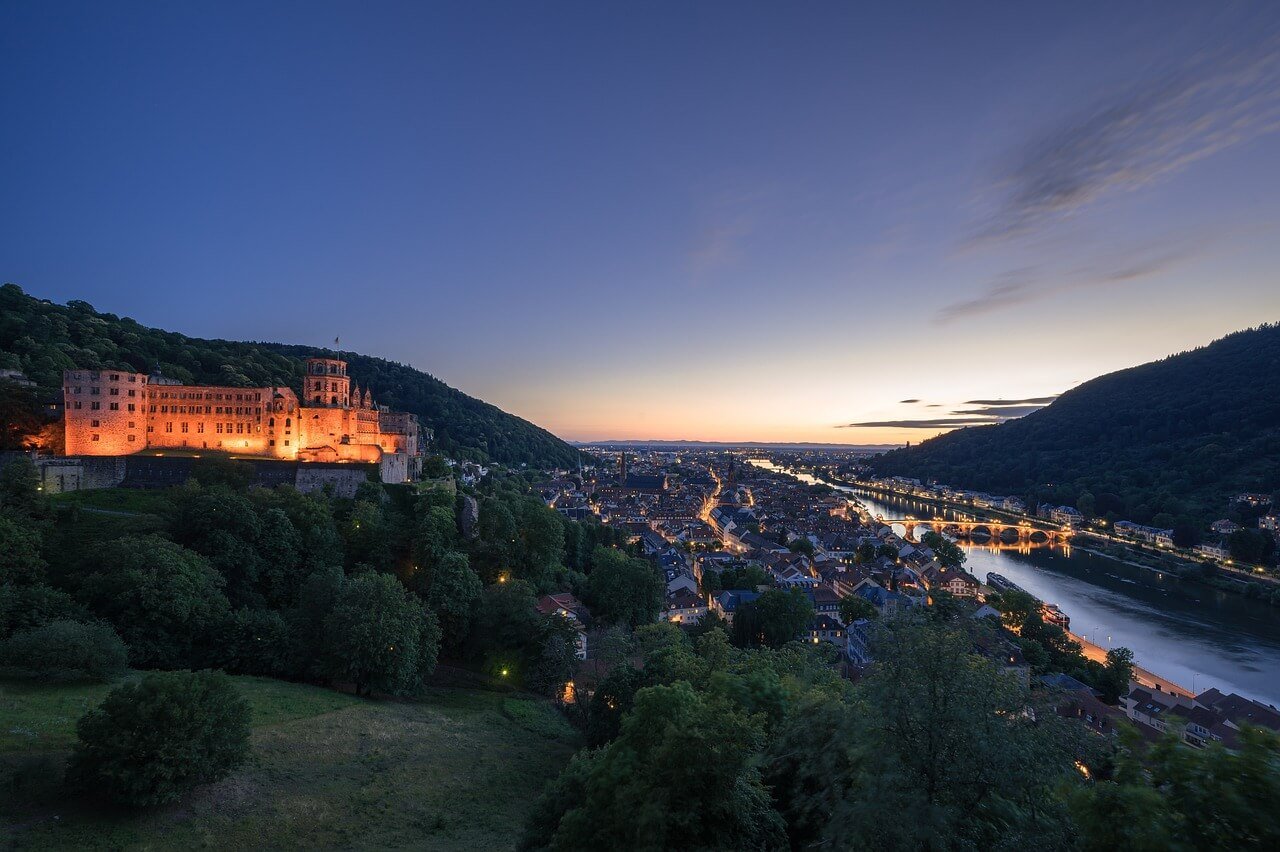
Heidelberg, one of the most visited tourist locations in Germany, is situated in the Neckar river valley. The city was largely spared from the allied bombers that destroyed the majority of Germany’s main inner cities during World War II. Heidelberg has so managed to hold onto its baroque elegance of winding alleyways, charming homes, and charming bridges.
Heidelberg Castle, a Renaissance-style stronghold located atop a hill overlooking the city, is the most recognizable sight in the area.
Other notable sights are the Church of the Holy Spirit and the Philosophers’ Walk, a picturesque riverbank walk. The latter is a distinctively designed church in the Gothic style. You should snap a ton of pictures of it.
Wandering around Heidelberg’s old city is a delightful experience, providing an insight into the city’s colorful and rich past.
17. Holstentor in Lübeck
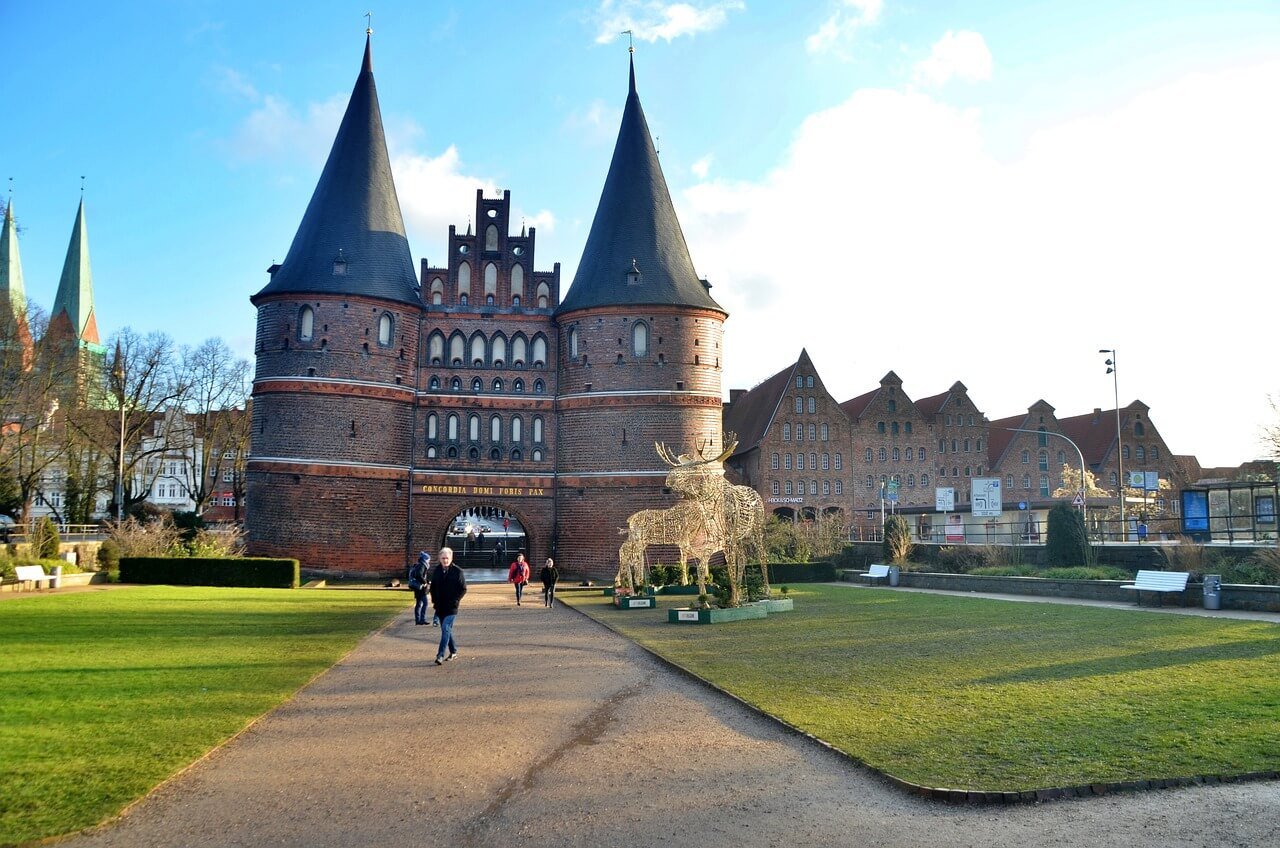
The Holstentor is Lübeck’s medieval city gate. It is one of the most identifiable landmarks in the city and dates back to the late 15th century.
The gate is regarded as a brick Gothic architectural marvel. Today, it serves as a museum presenting the history of the Hanseatic League and Lübeck.
This magnificent Gothic structure, which was finished in 1464, is a component of Lübeck’s medieval city defenses. There are two city gates that you can see; the other being the Citadel Gate.
Its two enthralling circular towers and arched entryway have earned it the status of a Lübeck icon. In conjunction with Lübeck’s historic city core, or Altstadt, it ranks among the most popular tourist destinations in Germany.
16. Cologne Cathedral

The most well-known sight in Cologne for centuries has been Cologne Cathedral (Kölner Dom), unquestionably the best Gothic cathedral in Germany. It is among the biggest and most well-known buildings of its sort in all of Europe. Building for the cathedral took place in the 12th and 13th centuries. However, work on it was put on hold and wasn’t finished until the late 19th century.
It is recognizable throughout the city with its twin spires. It is renowned for its ornate stained glass windows from the fourteenth to the twentieth centuries.
The cathedral is home to several significant pieces of art. The Shrine of the Three Kings is one of them. This helps to explain why it is such a famous attraction: it is said to contain the bones of the Three Wise Men.
15. Oktoberfest
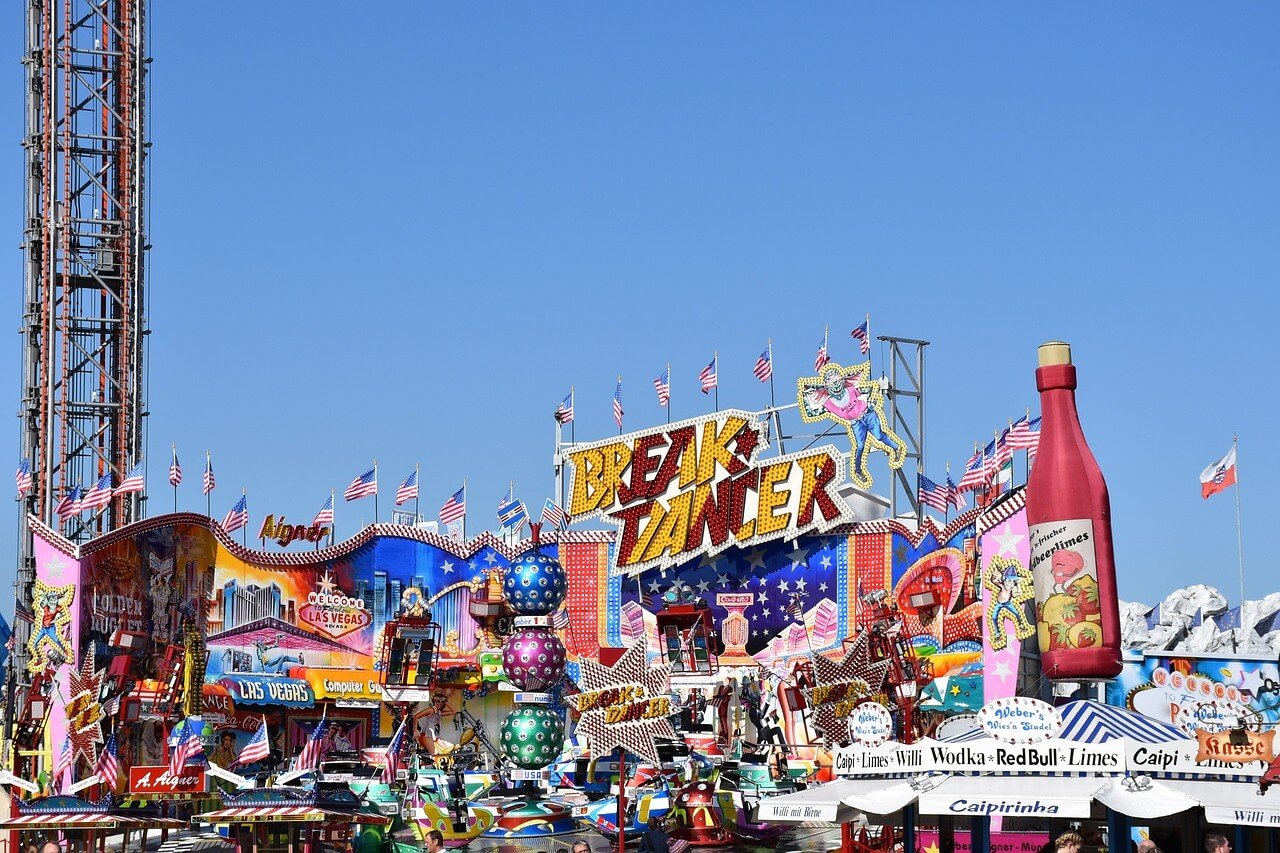
Munich hosts the renowned 16-day Oktoberfest every year from the end of September through the first weekend of October. It is the biggest beer festival in the world, drawing millions of people from every continent.
There are rides, music, German cuisine, and beer tents during the event. It also includes other events like contests and parades.
The celebration of King Ludwig I of Bavaria and Princess Therese von Sachsen-Hildburghausen’s marriage in 1810 is where the origins of Oktoberfest may be found. Since then, it has developed into a renowned worldwide occasion.
Wearing traditional German clothing allows tourists to fully immerse themselves in the culture. This entails wearing lederhosen for guys. It means that women need to wear dirndls. which all contribute to the joyous mood.
14. Lindau
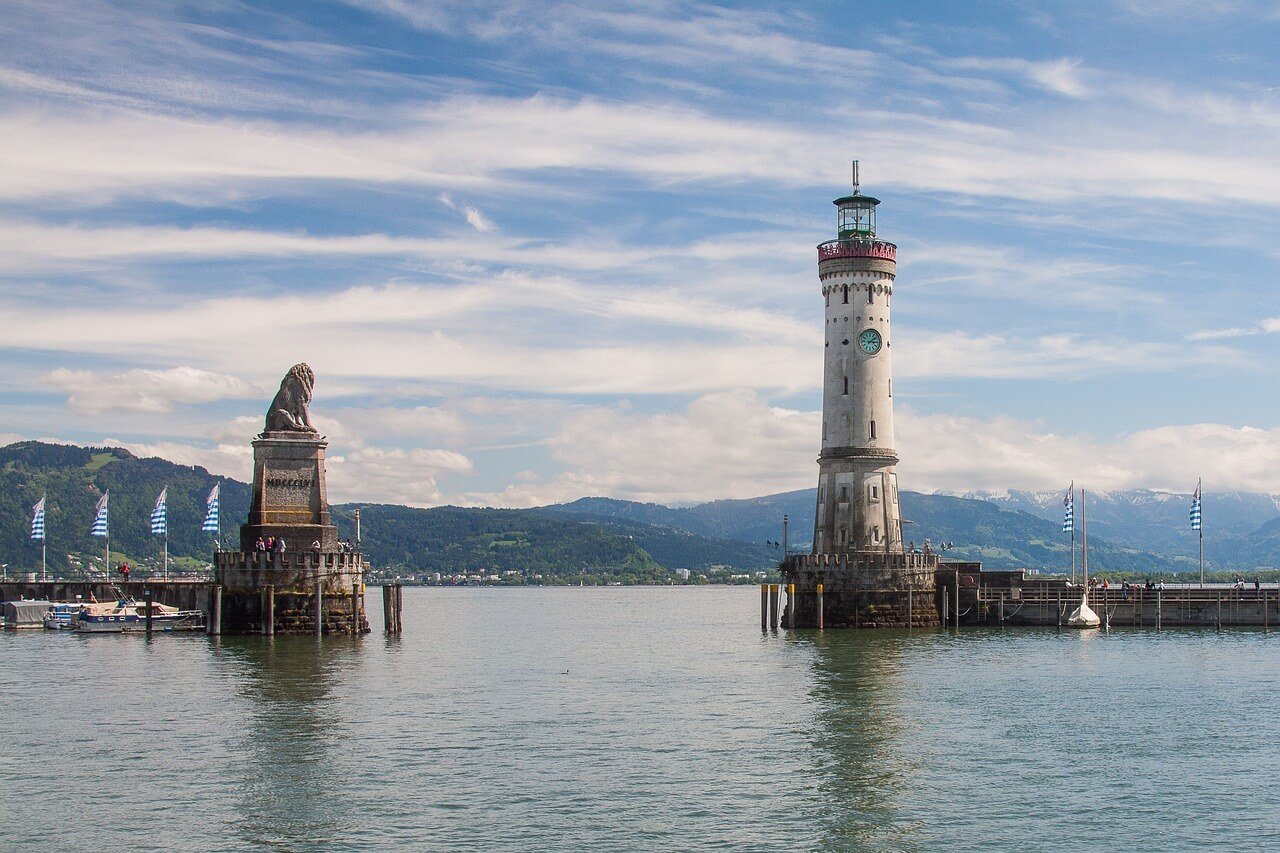
A charming town in southern Germany is called Lindau. Situated close to the Austrian border on an island in Lake Constance (Bodensee).
With 3,000 or so residents, the city is connected to the mainland via railroad and bridge. With its abundance of half-timbered and medieval structures, Lindau is a well-liked tourist destination.
Its charming port, one of its primary attractions, is home to a monument of a Bavarian lion, and its stone lighthouse offers views of the surrounding mountains and lakes.
The Lindau Nobel Laureate Meetings are another reason to visit the area. An annual gathering that unites young scientists and Nobel Prize recipients.
13. Frauenkirche in Dresden

In Dresden, there is a Lutheran church called Frauenkirche, or Church of Our Lady. It is renowned for its exquisite baroque architecture and is one of the most well-known sights in the city. Its towers and unusual dome are two of its most notable characteristics.
The 18th century saw the construction of the first church. When it was finished, it was hailed as one of the most spectacular ecclesiastical structures in all of Europe. But the church was devastated in World War II and remained in ruins for many years.
A significant endeavor to bring the church back to its former splendor was started in the 1990s. After a painstaking reconstruction procedure, it was eventually reopened in 2005.
The Frauenkirche is now a representation of Dresden’s tenacity. It is among the most well-liked tourist destinations in the city, drawing tourists from all over the globe.
12. Romantic Rhine

The Romantic Rhine is a gorgeous section of the Rhine in western Germany that is well-known for its amazing landscape and quaint towns.
The river runs from Bingen to Koblenz in this segment. Here, it winds over precipitous slopes covered with vineyards, crowned with an endless array of castles and ruins.
Since ancient times, the river has played a significant role in trade into central Europe, and a number of small towns have developed along its banks. Despite their limited size, a lot of these ancient villages still have a vintage atmosphere.
The Romantic Rhine is also well-known for its picturesque boat trips. These provide an amazing opportunity to fully appreciate the area’s natural splendor.
11. Black Forest

Situated in the southwest region of the nation is the Schwarzwald, sometimes known as the Black Forest. The forest’s name refers to its dense tree canopy, and it’s a haven for people who enjoy outdoor activities and breathtaking landscapes.
While mountain biking, hiking, and swimming in frigid Alpine lakes are popular activities, there are also some urban options in the Black Forest. There are several cities and settlements inside the forest. World-famous spa town Baden-Baden is the ideal place to unwind, while Freiburg is a vibrant university town with fantastic food and a vibrant nightlife.
10. Rothenburg Ob Der Tauber

Rothenburg ob der Tauber is a real-life fairytale village. This medieval village in France has been amazingly well maintained, seeming straight out of a fairy tale.
Many of the churches and homes overlooking the Tauber River are from the 15th and 16th century. The town’s focal point is the Market Square, which has the Town Hall Tower from the thirteenth century on one side.
It is particularly well-known for its yearly Christmas market, which has typical booths offering souvenirs, food, and beverages.
The striking ramparts and defenses of the town are also open to guided excursions. You may also get breathtaking views of the surrounding landscape from them.
09. Nuremberg Christmas Market
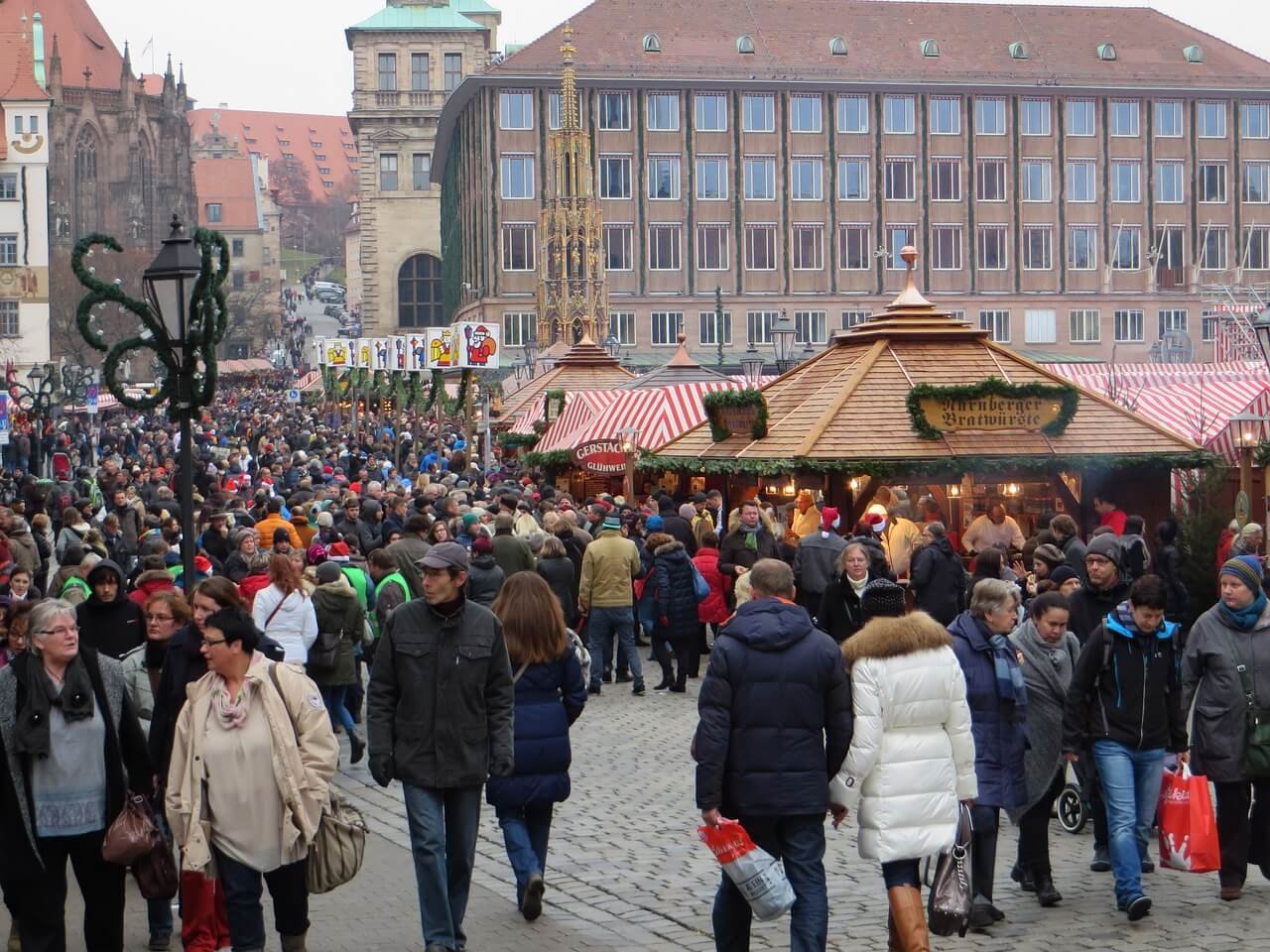
The world is familiar with German Christmas markets, and the Bavarian city of Nuremberg is home to what is possibly the greatest of them all.
Held yearly in the old town of Nuremberg, the Christkindlesmarkt dates back to the seventeenth century.
The market is well-known for its festive decorations and vintage ambiance. It includes holiday music, lights, and intricate wooden booths.
A large selection of handcrafted crafts, toys, and seasonal goodies are available for visitors to peruse and buy. The market also has a variety of foods and beverages, such as gingerbread and mulled wine.
In the weeks preceding Christmas, there is the Nuremberg Christmas Market. It is the centerpiece of the city’s holiday celebrations and one of the most well-liked activities in Germany.
08. Zugspitze
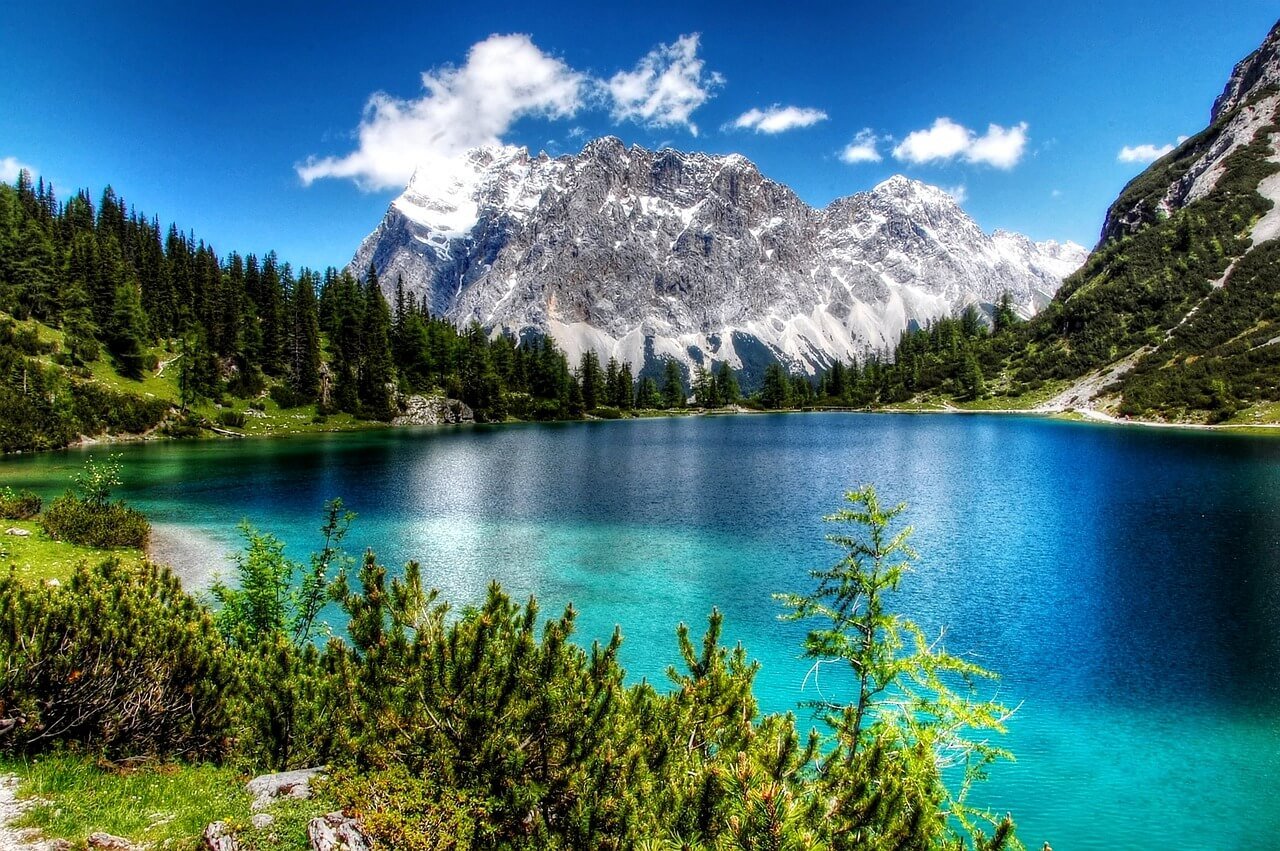
The tallest peak in Germany is the Zugspitze. Soaring to a height of 2,962 meters (9,718 feet), it is situated close to the Austrian border in the Bavarian Alps. Stunning sweeping views of the surrounding mountains and valleys can be seen from the peak.
Traveling to the summit is rewarding regardless of the season, even though the peak is a well-known destination for avid skiers worldwide. Take the Zahnradbahn, a cogwheel train that travels partially up the mountain, which departs from a lake near the mountain’s foot. After that, continue traveling by the Eibsee-Seilbahn cable car. From the peak, four nations’ worth of scenery may be seen simultaneously.
Zugspitze is known for its breathtaking scenery, but it also has a research station, a number of hotels, and dining establishments. They provide a handy starting point for exploring the neighboring mountain range.
07. Hohenzollern Castle

At the base of the Swabian Alps, the neo-Gothic Hohenzollern Castle is situated atop a cliff with a view of two tiny villages.
This well-liked tourist spot in central Germany, not far from the town of Hechingen, is renowned for both its breathtaking architecture and historical value. It also provides stunning views of the surrounding landscape.
The castle’s past is extensive. It was the ancestral home of the powerful Hohenzollern family for a considerable amount of time, who were influential in German history.
Its interiors have been maintained through several restorations and reconstructions throughout the ages, and tourists are welcome to explore them now. Grand halls, bedrooms, and chapels are among them; their elaborate details and opulent décor will astound you.
06. Reichstag in Berlin
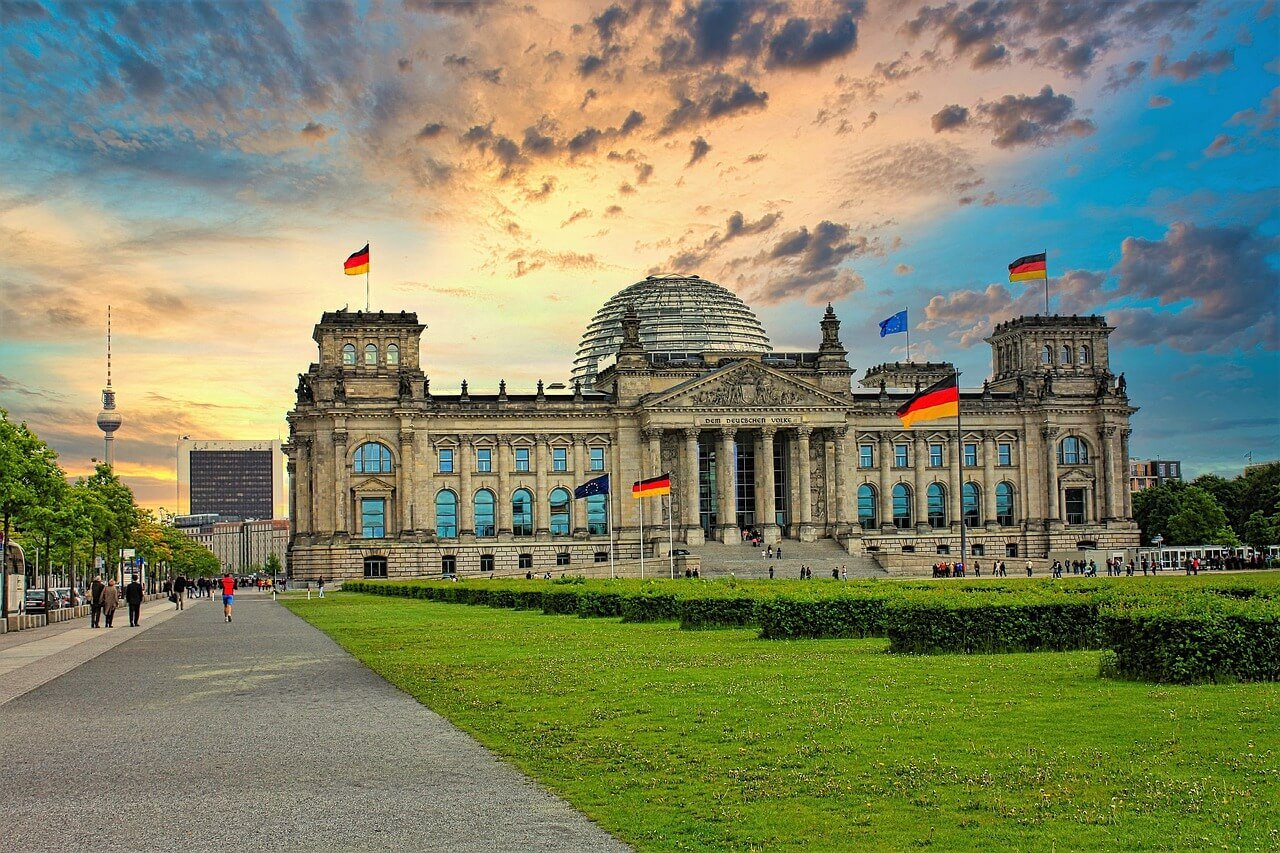
There are several ancient structures in Berlin, the nation’s capital, but the Reichstag is among the most significant.
The Reichstag, which dates back to the 19th century, underwent extensive renovations in the 1990s following significant damage during World War II. Berlin was designated as the nation’s capital when the Cold War ended, and the Reichstag was made the formal seat of government in Germany.
It currently has a magnificent glass dome that provides views of the city and looks amazing at night.
05. Berchtesgaden
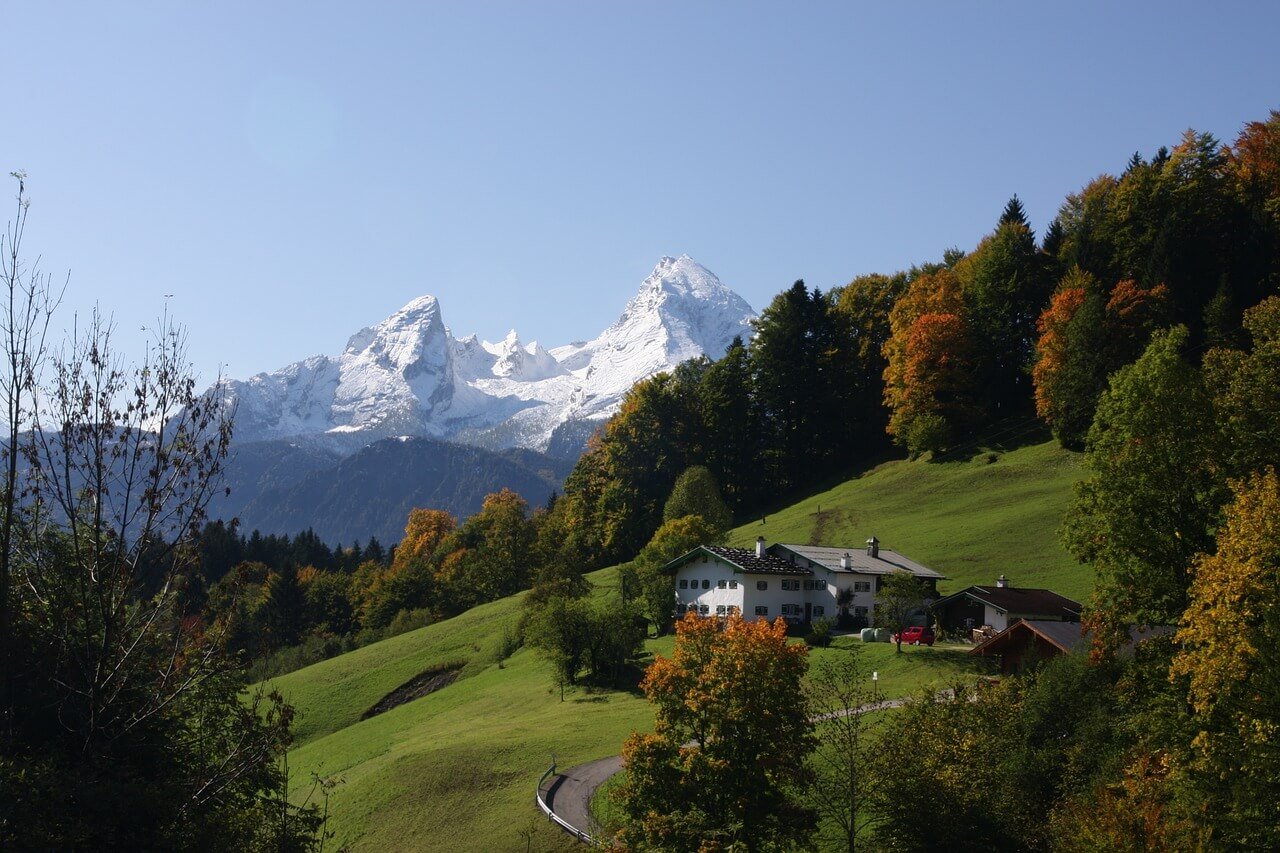
Berchtesgaden is tucked away in the southeast of the nation, close to the Austrian border.
It is regarded as one of Bavaria’s most exquisite areas and offers breathtaking alpine landscapes. For those who prefer winter sports like hiking, skiing, and snowboarding, it is also a paradise.
Berchtesgaden is home to a number of historic sites in addition to these activities. These include the Kehlsteinhaus above Berchtesgaden and the Königsee Lake. Hitler’s previous mountain hideaway was also referred to as the “Eagle’s Nest.” The building was preserved even after World War II and is currently used as a museum.
Berchtesgaden’s salt mines are another well-known feature. If you schedule a trip with them, you’ll be able to see a process that dates back thousands of years.
04. Rugen Cliffs
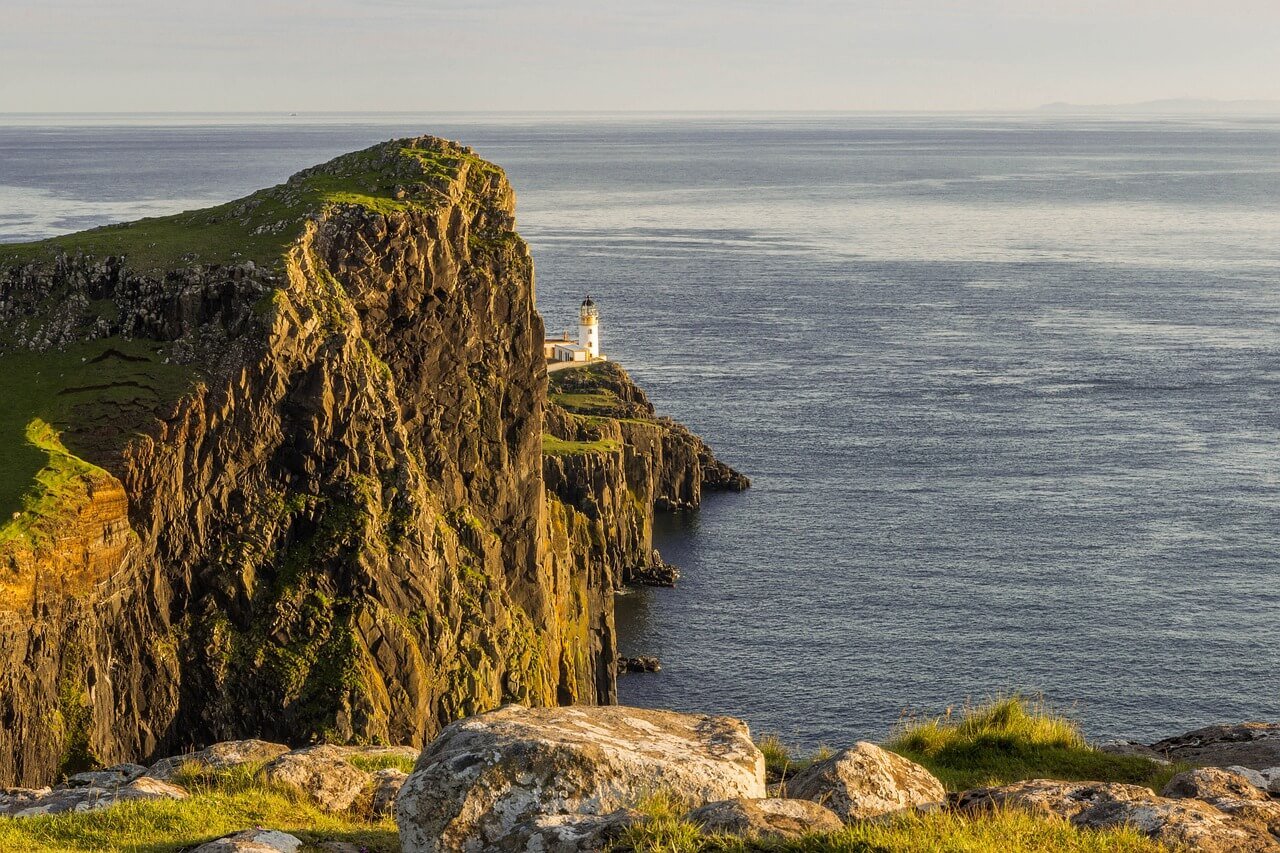
Germany’s largest island has a feature called the Rügen Cliffs, which are situated on the Pomeranian coast in the Baltic Sea.
You will need to go to the northeast German island of Rügen in order to reach them. But once you get there, the breathtaking seaside panorama ought to wow you.
High chalk cliffs like The King’s Chair are part of it; a visitor center with exhibits about Rügen environment and an observation platform are located there.
The cliffs are a well-liked vacation spot with access to immaculate sandy beaches, hiking paths, and places to go birding. It’s a component of the Jasmund National Park, which is well-known for white-tailed eagles and ancient beech trees.
A unique museum housed aboard the old submarine HMS Otus is located in the adjacent beach village of Sassnitz.
Map of Tourist Attractions in Germany
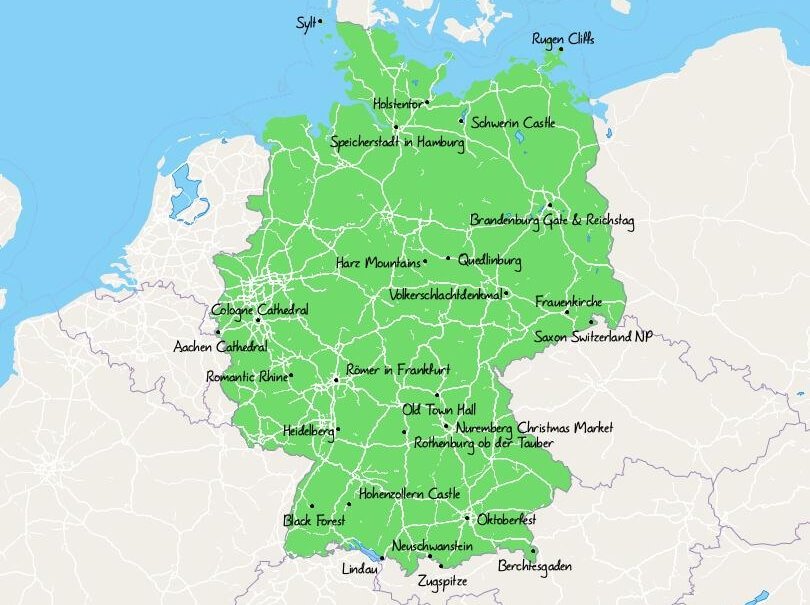



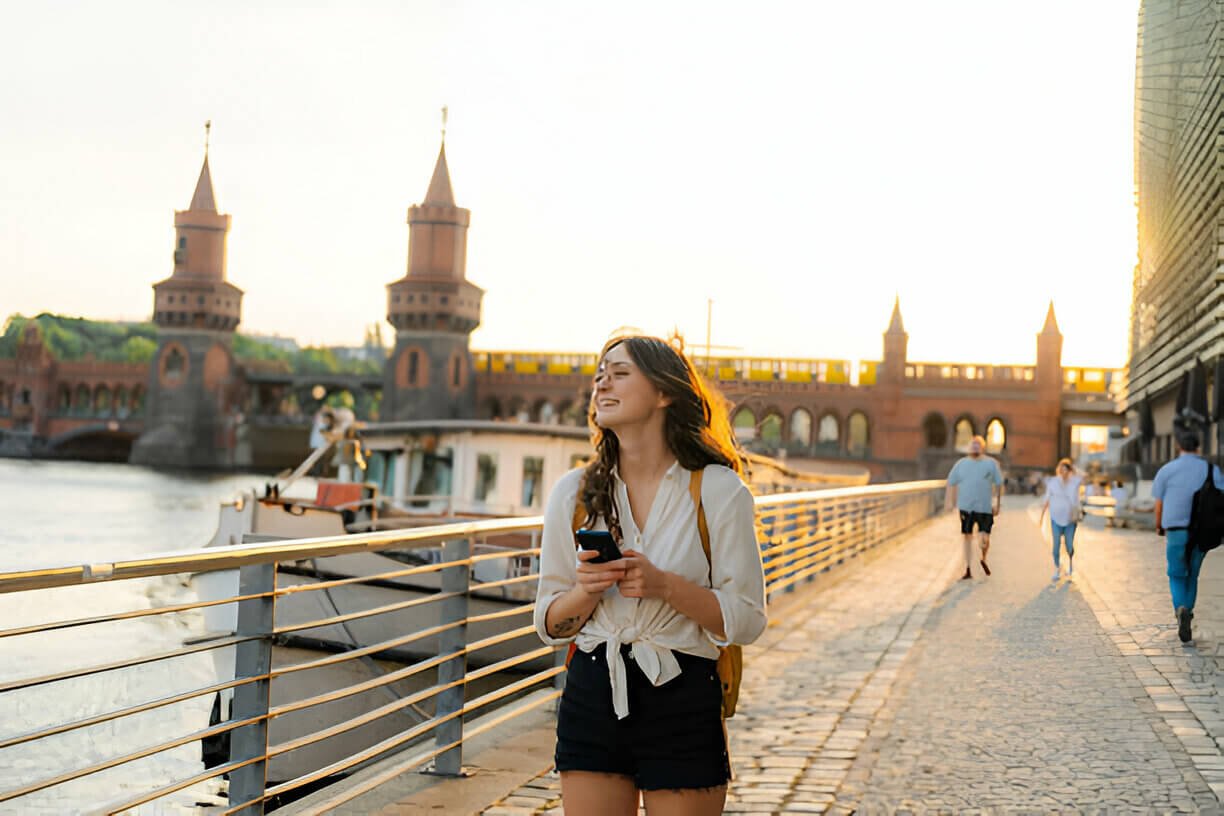
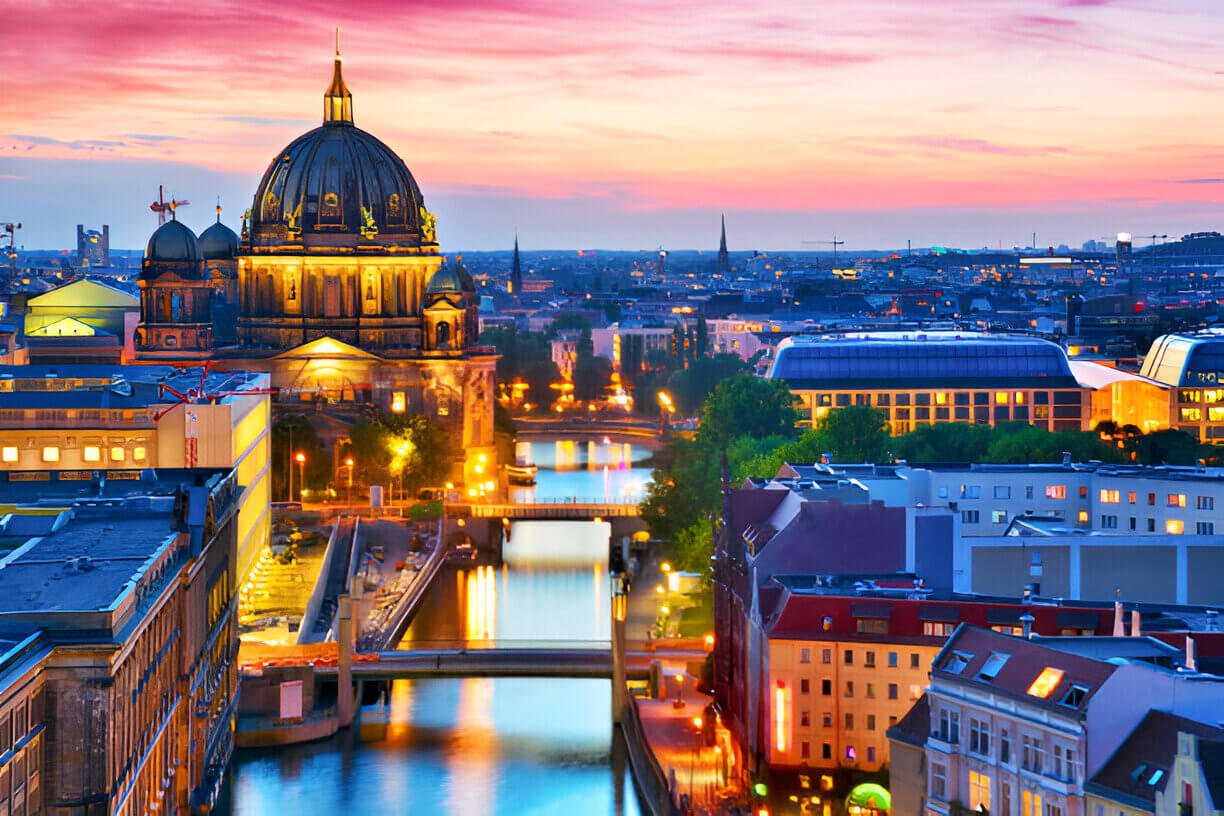
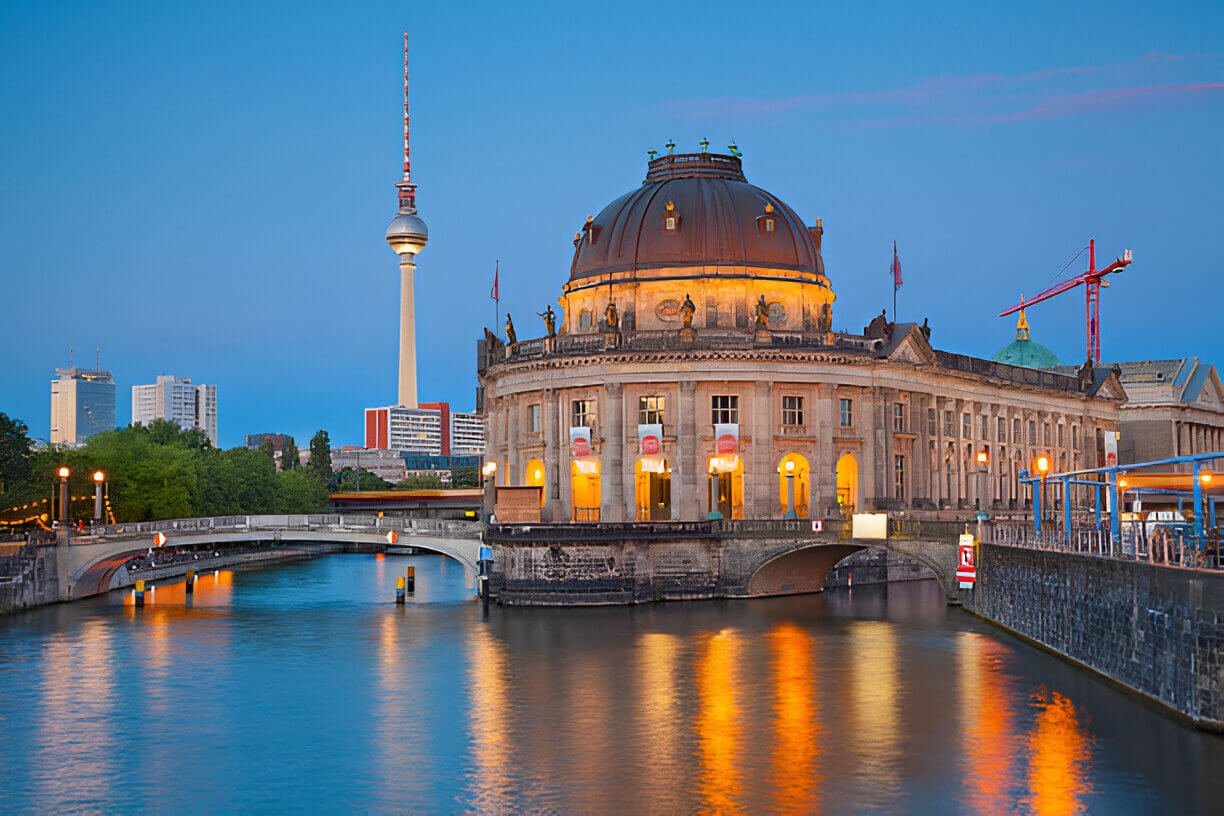
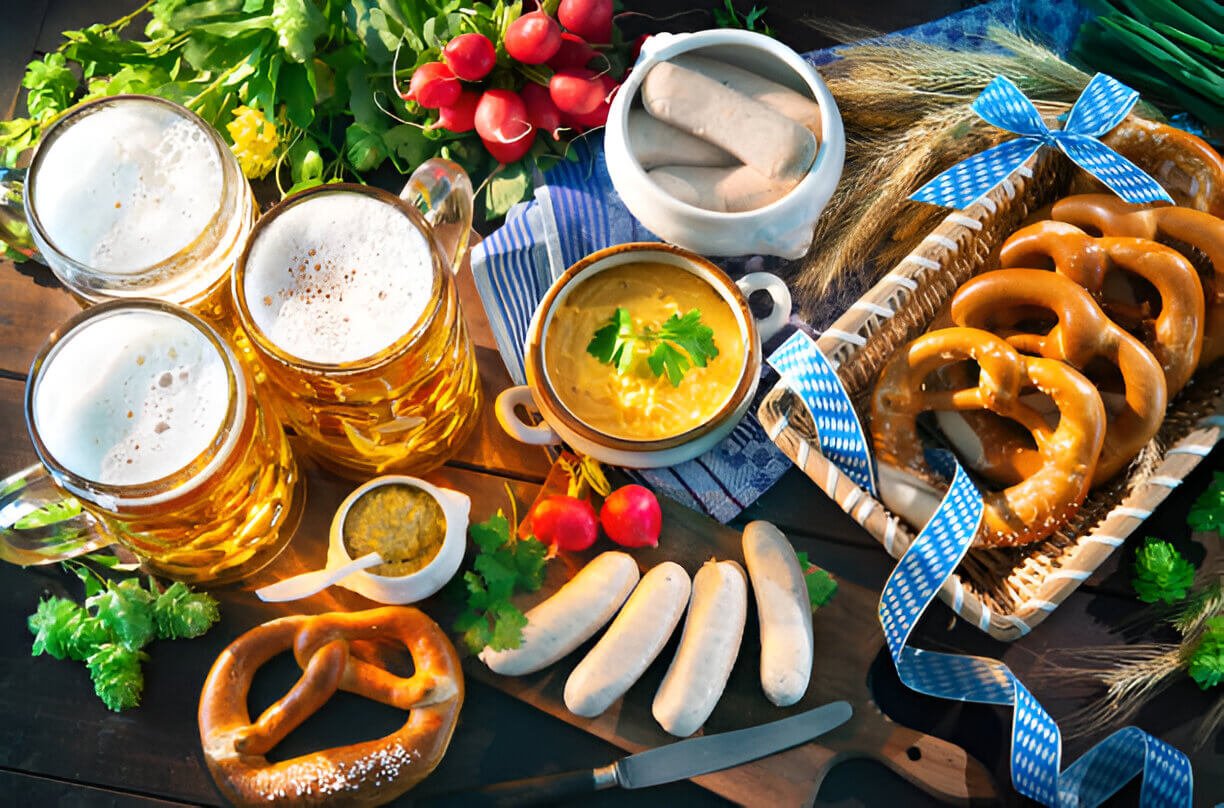
1 thought on “Top 30 Tourist Attractions in Germany”
Very Effective information for me.
Thank You sir.